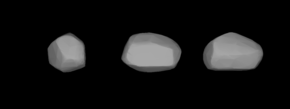260 Huberta
Appearance
 A three-dimensional model of 260 Huberta based on its light curve. | |
| Discovery | |
|---|---|
| Discovered by | Johann Palisa |
| Discovery date | 3 October 1886 |
| Designations | |
| (260) Huberta | |
| Pronunciation | ⫽hjuːˈbɜːrtə⫽ |
Named after | Hubertus |
| A886 TA, 1906 VH 1911 ME | |
| Main belt (Cybele) | |
| Orbital characteristics[1] | |
| Epoch 31 July 2016 (JD 2457600.5) | |
| Uncertainty parameter 0 | |
| Observation arc | 109.37 yr (39947 d) |
| Aphelion | 3.84026 AU (574.495 Gm) |
| Perihelion | 3.04743 AU (455.889 Gm) |
| 3.44384 AU (515.191 Gm) | |
| Eccentricity | 0.11511 |
| 6.39 yr (2334.3 d) | |
Average orbital speed | 16.05 km/s |
| 110.638° | |
| 0° 9m 15.188s / day | |
| Inclination | 6.41599° |
| 165.393° | |
| 180.996° | |
| Physical characteristics | |
| Dimensions | 94.67±3.6 km |
| 8.29 h (0.345 d) | |
| 0.0509±0.004 | |
| CX | |
| 8.97 | |
Huberta (minor planet designation: 260 Huberta) is a large asteroid orbiting near the outer edge of the Main belt. It is dark and rich in carbon.
It belongs to the Cybele group of asteroids[2] and may have been trapped in a 4:7 orbital resonance with Jupiter.
It was discovered by Johann Palisa on 3 October 1886 in Vienna and was named after Saint Hubertus.
References[edit]
- ^ "260 Huberta". JPL Small-Body Database. NASA/Jet Propulsion Laboratory. Retrieved 11 May 2016.
- ^ Lagerkvist, Claes-Ingvar; et al. (January 2001), "A Study of Cybele Asteroids. I. Spin Properties of Ten Asteroids", Icarus, 149 (1): 190–197, Bibcode:2001Icar..149..190L, doi:10.1006/icar.2000.6507.
- The Asteroid Orbital Elements Database
- Minor Planet Discovery Circumstances
- Asteroid Lightcurve Data File
External links[edit]
- 260 Huberta at AstDyS-2, Asteroids—Dynamic Site
- 260 Huberta at the JPL Small-Body Database
